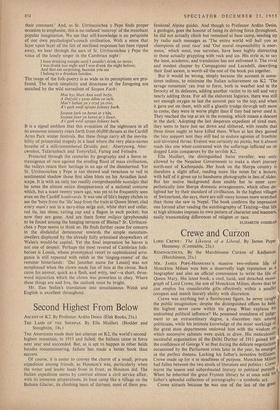Second Highest From gelow
ASCENT OF K2. By Professor Ardito Desio. (Elek Books, 21s.) THE Americans made their last attempt on K2, the world's second- highest mountain, in 1953 and failed; the Italians came in force next year and succeeded. But, as is apt to happen in other fields besides mountaineering, failure has made a better book than success.
Of course, it is easier to convey the charm of a small, private expedition among friends, as Houston's was, particularly when the writer and leader leads from in front, as Houston did. The . Italian expedition seems by contrast almost a civil service affair, with its immense preparations, its base camp like a village on the Baltoro Glacier, its climbing team of thirteen, most of them pro- fessional Alpine guides. And though to Professor Ardito Desio, a geologist, goes the honour of being its driving force throughout, he did not actually climb but remained at base camp, sending up by radio such messages as 'The entire world will hail you as champions of your race' and 'Our moral responsibility is enor- mous,' which must, one surmises, have been highly distracting to those actually grappling with rock and ice. His style is, to say the least, academic, and translation has not enlivened it. The vivid and modest chapter by Compagnoni and Lacedelli, describing their final ascent, is worth all the rest of the book put together.
But it would be wrong, simply because the account is some- times tedious, to minimise the Italian achievement on K2. The savage mountain' ran true to form, both in weather and in the ferocity of its defences, adding another victim to its toll and very nearly adding three. For all the elaborate logistics, there was still not enough oxygen to last the summit pair to the top, and when it gave out on them, with still a ghastly trudge through soft snow to come, they were in worse plight than if they had never used it. They reached the top at six in the evening, which meant a descent in the dark. Adopting the last desperate expedient of tired men, they seem to have just sat down and slithered, with -results that three times ought to have killed them. When at last they gained the tiny support tent they still had to endure agonies of frostbite and ulcerated throat. Everest was certainly no picnic, but it almost reads like one when contrasted with the sufferings inflicted on its dogged Latin conquerors by the terrible K2.
Ella Maillart, the distinguished Swiss traveller, was only allowed by the Nepalese Government to make a short journey north-east of Kathmandu. Her book on the Sherpa country is therefore a slight affair, reading more like notes for a lecture, with half of it given up to handsome photographs in lieu of slides. But her native background does enable her to enter sym- pathetically into Sherpa domestic arrangements, which often de- lighted her by their standard of civilisation. In the highest villages of Switzerland, she says, there are still many houses more wretched than those she saw in Nepal. The book confirms the impression one formed after reading the autobiography of Tenzing—that life at high altitudes imposes its own pattern of character and manners, easily transcending differences of religion or race.
ELIZABETH COXHEAD


































 Previous page
Previous page